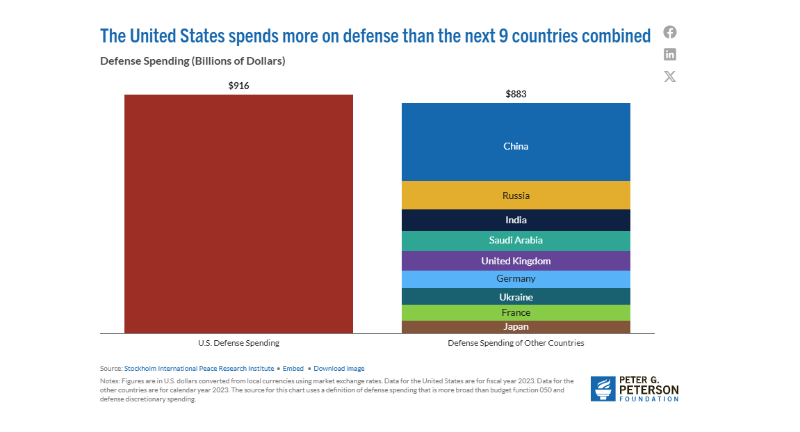The US wants us to believe we should be scared of China, buy nuclear subs to help fight her, and increase our military spending to 3% of GDP. But who is the real warmonger, asks historian Richard Cullen?
One way to get a brisk fix on who is most scary is to look back over the last decade or so. And then consider what has unfolded over the last few months.
America, with its Gothic military budget greater than the next nine nations combined and with close to 800 worldwide military bases, has been involved in non-stop global warfare over the last decade in the Middle East and beyond. In Afghanistan, the US spent over $2 trillion to replace the Taliban with the Taliban.
Any doubt about this war-mongering obsession (notwithstanding recent White House attempts to wind back the Ukraine war) has been comprehensively erased by the continuing mass homicidal horror stories emerging, month after month, from the hellscape created by Israel in Gaza, backed with obscene fervour by the US.

Over the same period, the drum-beat mantra for China has been, “let’s go to work” rather than “let’s go to war.”
China has not dropped a single hostile bomb anywhere over the last 40 years, as it has lifted over 800 million people out of abject poverty. It has grown to dominate global manufacturing in a manner never seen before, covering, for example, shipbuilding, all kinds of vehicles (especially electric cars), batteries, solar panels, green technology generally, the widest range of household and recreational items, plus medical necessities.
Moreover, Chinese web-based vending platforms such as Tmall, Alibaba and AliExpress are now selling A-to-Z goods directly to millions of global consumers at often unbeatable prices.
Belt and Road Initiative
Additionally, China’s building of all forms of transport and information infrastructure now eclipses comparable work currently being done across the Global West.
This intelligent, hard-working expertise also underpins the prominent global achievements of China’s trillion-dollar Belt and Road Initiative (BRI). It has not all been plain sailing for the BRI, but it is still far ahead, in terms of achievements, compared to its pallid Western imitators according to a 2023 report from Griffith University.
Furthermore, China has become a ground-breaking leader in space exploration, according to CNN, a sentiment echoed by The Economist, confirming that China is now a scientific superpower.
The Australian Strategic Policy Institute (ASPI) said in 2023 that China is leading the US in the technology race in all but a few fields.
These deliberately chosen, vastly divergent geopolitical arcs are reflected, too, in the macroeconomic development figures for America and China.
Over the 10 years to 2023, the US total GDP size increased from US$16.8 trillion to US$27 trillion, or 61%. In China, over the same period, total nominal GDP size increased from US$9.6 trillion to US$17.7 trillion, or 84%.
Measured in Purchasing Power Parity (PPP), China’s total economic size grew from $16.3 trillion in 2013 to $34.7 trillion in 2023, according to the World Bank – an increase of 112%.
Next, consider more recent comparative events.
The Trump factor
In America, Donald Trump commenced his second term as President on January 20, 2025. Much to his personal delight, it seems, he has dominated global headlines ever since.
The list of reasons why this is so is breathtaking: the wholesale sacking of federal employees, cowboy-style deportation round-ups, threats to take over Greenland and Panama and absorb Canada as the ”51st state, open hostility to the rule of law – and judges – internally and internationally, renaming the Gulf of Mexico, and tempestuous wielding of tariffs with much more of the same promised.
All this extraordinary, intimidating political creativity looks to be substantially based on a primary Hollywood-Western problem-solving mantra: “Shoot first and ask questions later.”
Meanwhile, the White House has been renamed the Fight House by the media as America’s vaunted Oval Office has been converted into a globalized humiliation chamber by President Trump and his team.
In Australia, retired admiral and former defence force chief Chris Barrie recently said “vandals” now occupied the White House, while Bob Carr, former Australian Foreign Minister, stated:
The US is utterly not a reliable ally.
In contrast, the annual “Two Sessions” meetings for 2025 – of the National People’s Congress (NPC) and the Chinese People’s Political Consultative Conference (CPPCC) – were held in Beijing.
The American political scientist Rush Doshi, an articulate America-first devotee who knows China exceptionally well, recently observed how dense and dry the deliberations of the Communist Party of China (CPC) are. But he also confirmed how effective the CPC has proved to be, over time, in running China using this experience-based, intensely planned approach.
Books could be written to discuss, in detail, why Washington’s scowling “Orange Peril” project now looks so dominantly menacing, notwithstanding the extraordinary continual effort by the Western mainstream media to advance their cherished “Neo Yellow Peril” narrative. History will show at whose peril it actually will be.
Richard Cullen is an Adjunct Professor in the Faculty of Law at the University of Hong Kong. He was previously a Professor in the Department of Business Law and Taxation at Monash University in Melbourne, Australia.

